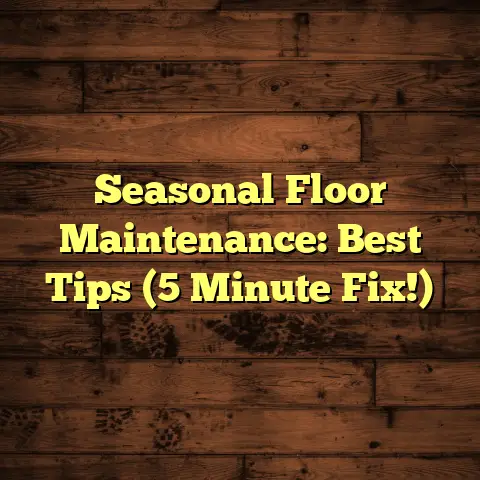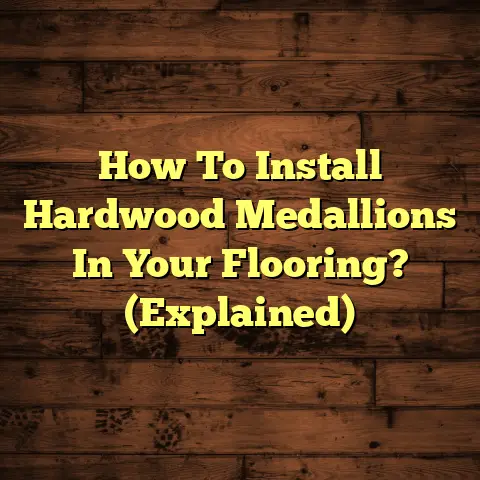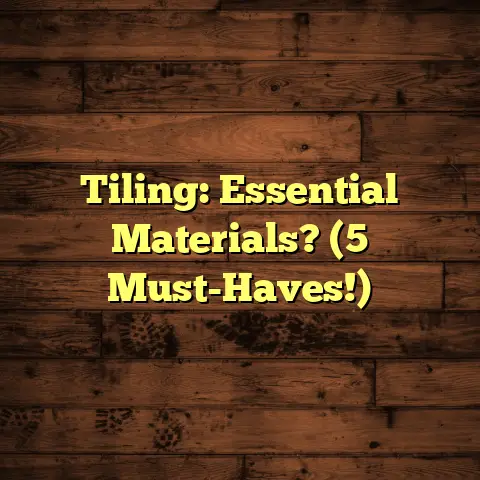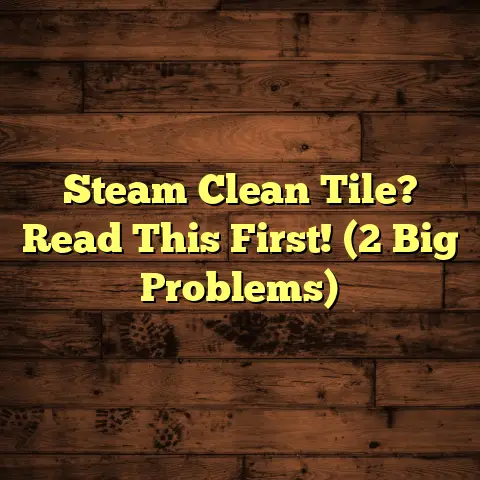Make Limestone Floors Shine (2 Buffing Secrets!)
But let’s be real – maintaining that shine? That’s where many homeowners and property managers hit a wall. Over time, those stunning floors can start to look dull, losing their luster and charm.
But what if I told you that you could transform your lackluster limestone into a surface so brilliant, it’ll catch every eye? And what if I said it’s easier than you think?
I’m going to share two essential buffing secrets that will not only rejuvenate your limestone floors but also make maintenance a breeze. Ready to unlock the potential of your floors? Let’s dive in!
Section 1: Understanding Limestone Floors
So, what exactly is limestone?
Simply put, it’s a sedimentary rock, primarily composed of calcium carbonate. This composition gives it that beautiful, natural look.
It’s a popular choice for flooring because of its unique qualities:
- Porous Nature: Limestone is like a sponge – it can absorb liquids, which makes it susceptible to staining if not properly sealed.
- Natural Variations: Each piece of limestone is unique, with variations in color, texture, and veining. This is part of its charm!
Now, let’s talk about the not-so-charming stuff. What are the common issues you might face as a limestone floor owner?
- Dullness: Over time, the surface can lose its shine due to foot traffic and everyday wear.
- Stains: Spills happen! And because limestone is porous, stains can penetrate deep.
- Scratches: Even small particles of dirt and grit can scratch the surface, especially in high-traffic areas.
I’ve seen it all – from coffee spills to scratches from pets. The key to avoiding these problems? Regular maintenance and care. Think of it like brushing your teeth – a little effort every day goes a long way!
Section 2: The Science Behind Buffing Limestone
Okay, let’s get a little technical. What is buffing, and why is it different from just cleaning or polishing?
Buffing is a process that uses a powered machine with a rotating pad to gently abrade the surface of the limestone.
Think of it as a gentle exfoliation for your floors! This process removes surface imperfections, polishes the surface, and restores shine.
Here are the tools and materials you’ll typically need:
- Floor Buffer: This is the main machine. We’ll talk about different types later.
- Buffing Pads: These come in various materials and grits, depending on the job.
- Cleaning Solutions: Specifically designed for limestone, these help remove dirt and grime before buffing.
The mechanics behind buffing are pretty cool. The rotating pad creates friction, which generates heat. This heat, combined with the abrasive action of the pad, helps to:
- Remove Surface Imperfections: Tiny scratches and dull spots are gently buffed away.
- Re-polish the Surface: The buffing action smooths out the surface, creating a reflective shine.
I like to think of it as bringing out the hidden potential of the limestone!
Section 3: Buffing Secret #1 – The Right Tools
Make All the Difference
Alright, let’s get to our first secret: choosing the right tools. This is HUGE. Using the wrong tools can actually damage your limestone floors.
First up, let’s talk about floor buffers. There are two main types:
- Rotary Buffers: These have a single pad that rotates in a circular motion. They’re powerful and great for heavy-duty cleaning and polishing. However, they can be tricky to control and can leave swirl marks if you’re not careful.
- Orbital Buffers: These have a pad that vibrates in a random orbital motion. They’re easier to control than rotary buffers and less likely to leave swirl marks. They’re a good choice for beginners or for more delicate buffing.
Which one is right for limestone?
In my experience, an orbital buffer is generally safer and more effective for limestone. It’s gentle enough to avoid damaging the surface, but still powerful enough to restore shine.
Now, let’s talk about pads. The pad material you choose will depend on the condition of your limestone and the finish you want to achieve. Here are a few options:
- Diamond Pads: These are the most abrasive pads and are used for heavy-duty cleaning and polishing. They can remove deep scratches and stains, but should be used with caution on limestone.
- Wool Pads: These are softer than diamond pads and are used for polishing and buffing. They’re a good choice for restoring shine without being too abrasive.
- Microfiber Pads: These are the softest pads and are used for light cleaning and polishing. They’re great for maintaining the shine of your limestone floors after buffing.
How do you choose the right pad?
Here’s my rule of thumb:
- Assess the Condition: If your floors have deep scratches or stains, you might need to start with a diamond pad.
- Consider the Finish: If you just want to restore shine, a wool or microfiber pad will do the trick.
- Test in an Inconspicuous Area: Always test the pad in a small, hidden area to make sure it doesn’t damage the limestone.
Tips for Using Your Tools:
- Read the Manual: I know, it’s boring, but it’s important! Understand how your buffer works before you start.
- Start Slow: Begin with the lowest speed setting and gradually increase it as needed.
- Use Even Pressure: Avoid pressing down too hard, as this can damage the limestone.
- Keep the Pad Clean: Regularly clean the pad to remove dirt and debris.
Choosing the right tools can feel overwhelming, but trust me, it’s worth the effort. It’s the foundation for achieving a beautiful, long-lasting shine!
Section 4: Buffing Secret #2 – The Perfect Buffing
Technique
Okay, you’ve got the right tools. Now, let’s unlock the second secret: mastering the buffing technique. This is where the magic happens!
Here’s my step-by-step guide:
- Preparation:
- Clear the Area: Remove all furniture and obstacles from the room.
- Sweep or Vacuum: Thoroughly clean the floors to remove any loose dirt or debris.
- Clean the Floors: Use a limestone-safe cleaner to remove any stains or grime. Let the floors dry completely.
- Execution:
- Attach the Pad: Secure the appropriate buffing pad to the floor buffer.
- Start Buffing: Begin in one corner of the room and work in small sections.
- Overlap Your Passes: Overlap each pass by about 50% to ensure even coverage.
- Maintain a Consistent Speed: Keep the buffer moving at a consistent speed to avoid uneven polishing.
- Use the Right Pressure: Apply gentle, even pressure. Let the buffer do the work.
- Post-Buffing Care:
- Sweep or Vacuum: Remove any dust or debris created by the buffing process.
- Clean the Floors Again: Use a limestone- safe cleaner to remove any remaining residue.
- Apply a Sealer: This will help protect the limestone from future stains and damage.
Key Techniques to Remember:
- Pressure: Too much pressure can scratch the limestone. Too little pressure won’t effectively polish the surface. Find that sweet spot!
- Speed: Too fast can create swirl marks. Too slow can lead to uneven polishing. Experiment to find the right speed for your buffer.
- Movement Patterns: Use a consistent pattern, such as overlapping rows or a figure-eight motion, to ensure thorough coverage.
Why work in sections?
Working in sections allows you to focus on specific areas and ensure that you’re achieving consistent results. It also prevents you from getting overwhelmed by the task.
I like to break the room down into manageable chunks, like 4×4 foot squares. This helps me stay organized and focused.
Section 5: Maintenance Tips for Long-lasting Shine
You’ve buffed your limestone floors to perfection. Now, how do you keep them looking that way?
Here are some maintenance tips to keep in mind:
- Regular Cleaning: Sweep or vacuum your limestone floors at least once a week to remove dirt and debris.
- Use the Right Cleaning Products: Avoid acidic cleaners, as they can damage the limestone. Use a pH-neutral cleaner specifically designed for limestone.
- Protect Against Spills: Clean up spills immediately to prevent staining.
- Use Mats and Rugs: Place mats or rugs in high-traffic areas to protect the limestone from scratches and wear.
- Seal Your Floors: Apply a limestone sealer every 1-2 years to protect against stains and damage.
Choosing the Right Cleaning Products:
Look for cleaners that are specifically labeled as “limestone safe” or “pH neutral.” Avoid cleaners that contain:
- Vinegar
- Lemon Juice
- Ammonia
- Bleach
These ingredients can etch or damage the surface of the limestone.
Protecting Your Floors from Damage:
- Use Furniture Pads: Place felt pads under furniture legs to prevent scratches.
- Trim Pet Nails: Keep your pet’s nails trimmed to minimize scratches.
- Avoid Harsh Chemicals: Never use harsh chemicals or abrasive cleaners on your limestone floors.
Section 6: Troubleshooting Common Issues
Even with the best tools and techniques, you might encounter some issues during the buffing process. Here are some common problems and how to troubleshoot them:
- Uneven Shine: This can be caused by uneven pressure, inconsistent speed, or using the wrong pad. Try adjusting your technique or switching to a different pad.
- Stubborn Stains: Some stains are just plain stubborn! Try using a poultice to draw out the stain. A poultice is a paste made from absorbent materials, such as baking soda or diatomaceous earth, mixed with water or a limestone-safe cleaner.
- Scratches Still Visible: If scratches are still visible after buffing, you might need to use a more abrasive pad or seek professional assistance.
When to Call a Professional:
Sometimes, the damage is too severe for DIY buffing. Here are some situations where you should consider calling a professional:
- Deep Scratches or Etching: If the scratches or etching are deep, a professional can use specialized equipment to grind down the surface and restore it.
- Extensive Staining: If you have extensive staining, a professional can use specialized cleaning solutions and techniques to remove the stains.
- You’re Not Comfortable Doing It Yourself: If you’re not comfortable buffing your own floors, it’s always best to leave it to the professionals.
Conclusion: The Transformation Awaits
So there you have it – my two buffing secrets for making limestone floors shine!
With the right tools, the perfect technique, and a little bit of elbow grease, you can transform your dull, lackluster limestone into a surface that’s both beautiful and durable.
Remember:
- Choose the Right Tools: An orbital buffer and the appropriate pads are essential.
- Master the Technique: Use consistent pressure, speed, and movement patterns.
- Maintain Your Floors: Regular cleaning and sealing will help keep your limestone floors looking their best.
Don’t be afraid to experiment and find what works best for you and your floors. And if you ever feel overwhelmed, don’t hesitate to call a professional.
Now go forth and make those limestone floors shine! You got this!





